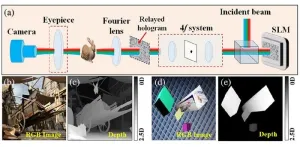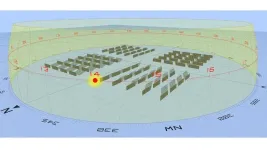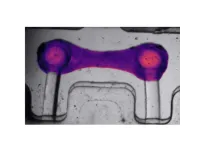(Press-News.org) URBANA, Ill. – Carbon monoxide emissions from industrial production have serious consequences for human health and are a strong indicator of overall air pollution levels. Many countries aim to reduce their emissions, but they cannot control air flows originating in other regions. A new study from the University of Illinois Urbana-Champaign looks at global flows of air pollution and how they relate to economic activity in the global supply chain.
“Our study is unique in combining atmospheric transport of air pollution with supply chain analysis as it tells us where the pollution is coming from and who is ultimately responsible for it,” said lead author Sandy Dall’erba, professor in the Department of Agricultural and Consumer Economics (ACE) and director of the Center for Climate, Regional, Environmental and Trade Economics (CREATE), both part of the College of Agricultural, Consumer and Environmental Sciences (ACES) at Illinois.
“There is a direct link between a country’s level of production and how much air pollution is emitted. But production may be driven by demand from consumers in other countries. We use supply chain analysis to quantify the links between production and consumption. This helps us to understand how production in one country is linked to domestic and foreign demand,” he added.
The researchers traced the movement of pollutants through the atmosphere to understand the flow of emissions, using simulations developed by Nicole RIemer, professor in the Department of Climate, Meteorology & Atmospheric Sciences, College of Liberal Arts & Sciences at Illinois. For analytical purposes, they divided the world into five sections: the United States, Europe, China, South Korea, and the rest of the world. South Korea is located downwind of China, and it serves as an example of how a small country can be affected by pollution from a much larger upwind neighbor.
“Over recent years, South Korea has taken several measures to reduce its own pollution, yet it has experienced worsening air quality. Why? The answer is to be found in its upwind neighbor, China. Yet, a large amount of the goods manufactured in China are destined for foreign consumers in the U.S. and in Europe, among other places. As such, who is to be blamed for the increase in air pollution in South Korea? That is the challenge we embarked on with this study,” Dall’erba stated.
The researchers found the amount of carbon monoxide emissions coming from China to South Korea increased from 30 teragrams (Tg) in 1990 to 42 Tg in 2014.
“To put these numbers in perspective, 5 Tg of carbon monoxide corresponds to the emissions from all of the cars in the U.S. – roughly 274 million – each driving 13,500 miles per year. So it’s definitely not a small increase. We conclude that South Korea has, in effect, lost control of their own air quality,” Dall’erba explained.
Dall’erba and his colleagues conducted a structural decomposition analysis to identify the economic drivers of carbon monoxide emissions in the five study regions. They found that while China’s technological processes to reduce pollution have improved, overall carbon monoxide emissions have gone up because the country’s production has increased.
Next, the researchers sought to identify where the demand that drives the increased production comes from. In China’s case, some of the increase can be attributed to U.S. and European demand, but it is primarily driven by households in China. The Chinese population grew considerably between 1990 and 2014, and the country became wealthier, leading to higher consumption, Dall’erba noted.
“Our findings show that pollution is a global concern that can’t be solved by individual countries. The world is connected, and we’re all in this together,” said co-author Yilan Xu, associate professor in ACE. “Pollution in one country can result from economic activities in neighboring countries, which in turn is influenced by who's demanding the goods produced in that country. Pollution emitted anywhere in the world is going to have consequences all over the world to varying degrees.”
Dall’erba, Riemer, and Xu emphasize that everybody can play a part in reducing emissions. Producers can implement technological change; policymakers can issue regulations or provide incentives; and consumers can make choices that favor sustainable products.
The paper, “Identifying the key atmospheric and economic drivers of global carbon monoxide emission transfers” is published in Economic Systems Research [doi.org/10.1080/09535314.2023.2300787]. Authors are Sandy Dall’erba, Nicole Riemer, Yilan Xu, Ran Xu and Yu Yao. The study was supported by a seed grant from the Institute for Sustainability, Energy, and Environment (iSEE) at Illinois.
END
Illinois study identifies atmospheric and economic drivers of global air pollution
2024-04-08
ELSE PRESS RELEASES FROM THIS DATE:
Advancing real-time 3D holographic display: A breakthrough in computer-generated holography
2024-04-08
Holographic displays offer a promising avenue for achieving lifelike 3D reproductions with continuous depth sensation, holding potential applications in fields such as entertainment, medical imaging, and virtual reality. However, the conventional methods for generating computer-generated holograms (CGHs) rely on repetitive computations, leading to increased computational complexity and impracticality for real-time applications.
To tackle this issue, researchers from the University of Shanghai for Science and Technology (China) have introduced a novel method for CGH generation that significantly reduces computational overhead while ...
New study shows renewable energy could work as power source at the Amundsen-Scott South Pole Station
2024-04-08
A recent analysis shows that renewable energy could be a viable alternative to diesel fuel for science at the South Pole. The analysis deeply explores the feasibility of replacing part of the energy production at the South Pole with renewable sources.
For almost as long as humans have spent time in Antarctica, the continent has been a home for science. One of the research outposts located there is the Amundsen-Scott South Pole Station. The science done there includes studies of climate change and cosmology.
Currently, ...
Cathie Biga is new American College of Cardiology president
2024-04-08
Cathie Biga, MSN, FACC, today became president of the American College of Cardiology and made history as the organization’s first non-physician president. She will serve a one-year term representing over 56,000 cardiovascular care team members around the world and leading the cardiovascular organization in its mission to transform cardiovascular care and improve heart health for all.
“I’m excited to bring my own set of leadership skills and perspectives to the ACC as we kick off the first year of our new Strategic Plan and celebrate the College’s 75th ...
Data shows medical marijuana use decreased in states where recreational use became legal
2024-04-08
Embargoed for release until 5:00 p.m. ET on Monday 8 April 2024
Annals of Internal Medicine Tip Sheet
@Annalsofim
Below please find summaries of new articles that will be published in the next issue of Annals of Internal Medicine. The summaries are not intended to substitute for the full articles as a source of information. This information is under strict embargo and by taking it into possession, media representatives are committing to the terms of the embargo not only on their own behalf, ...
Houston-area energy startup incubator wins phase 1 of DOE competition
2024-04-08
The U.S. Department of Energy’s Office of Technology Transitions (OTT) selected Texas Innovates, a non-profit organization focused on hydrogen and carbon innovation and expansion in the greater Houston and Gulf Coast region, as one of 23 phase 1 winners of the Energy Program for Innovation Clusters (EPIC) Round 3 competition. Notably, Texas Innovates is the only Texas entity to advance to phase 2 of the competition.
“We have been working towards this day since we identified the need for energy hardware incubation in 2017 and were a finalist in 2019 for C40 Cities global competition to make Houston’s Velasco Incinerator ...
A pulse of innovation: AI at the service of heart research
2024-04-08
A Pulse of Innovation: AI at the Service of Heart Research
Columbia biomedical engineers use AI to build a transformative new tool to study and diagnose heart function
Understanding heart function and disease, as well as testing new drugs for heart conditions, has long been a complex and time-consuming task. A promising way to study disease and test new drugs is to use cellular and engineered tissue models in a dish, but existing methods to study heart cell contraction and calcium handling require a good deal of manual work, are prone to errors, and need expensive specialized equipment. There clearly is a critical medical ...
Targeting vulnerability in B-cell development leads to novel drug combination for leukemia
2024-04-08
Despite having an overall survival rate of 94%, B-cell acute lymphoblastic leukemia (B-ALL), the most common childhood cancer, can prove challenging to treat, with survival among relapsed or resistant cases falling between 30-50%. Recent work by St. Jude Children’s Research Hospital scientists discovered which tumor cells resist treatment and why. This enabled the rational design of a combination therapy that better controlled high-risk subtypes of B-ALL in mouse models. The findings were published today in Cancer Cell.
“We found a new explanation of B-ALL ...
People make more patient decisions when shown the benefits first
2024-04-08
Key takeways
UCLA psychologists asked experiment participants to choose to receive $40 in seven days or $60 in 30 days, for example, under a variety of time constraints.
The experiment showed that people tend to make more impulsive decisions if they think about time delays first, and more patient decisions if they think about the greater reward associated with waiting longer.
The findings could be applied where people are being encouraged to make life choices that will benefit them in the long run, such as eating healthier, exercising or saving for retirement, by emphasizing the future large rewards and deemphasizing ...
New diagnostic tool achieves accuracy of PCR tests with faster and simpler nanopore system
2024-04-08
EMBARGOED UNTIL APRIL 8, 2024 AT 3:00 PM U.S. ET/ 12:00 PM PT
Over the past four years, many of us have become accustomed to a swab up the nose to test for COVID-19, using at-home rapid antigen tests or the more accurate clinic-provided PCR tests with a longer processing time. Now a new diagnostic tool developed by UC Santa Cruz Distinguished Professor of Electrical and Computer Engineering Holger Schmidt and his collaborators can test for SARS-CoV-2 and Zika virus with the same or better accuracy as high-precision PCR tests in a matter of hours.
In a new paper in the journal Proceedings of the National Academy of Sciences, Schmidt ...
Pregnancy accelerates biological aging in a healthy, young adult population
2024-04-08
Pregnancy may carry a cost, reports a new study from the Columbia University Mailman School of Public Health. The research, carried out among 1735 young people in the Philippines, shows that women who reported having been pregnant looked biologically older than women who had never been pregnant, and women who had been pregnant more often looked biologically older than those who reported fewer pregnancies. Notably, the number of pregnancies fathered was not associated with biological aging among same-aged cohort ...







